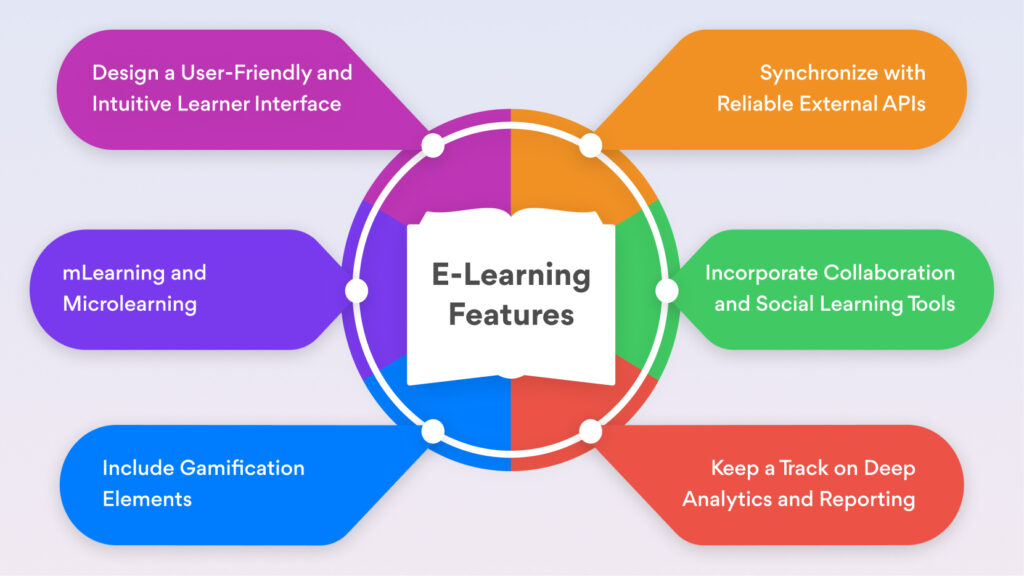Posted on
November 13, 2024
Read time
 5 mins read
5 mins read
E-learning has revolutionised the way we learn and train. Many forms of instructional design, especially multimedia have changed their approach based on the latest trends in custom e-Learning development. Moreover, due to the introduction of digital technologies, and the consequent call for e-learning, the e-learning industry has expanded considerably. As analysed by GlobNewswire, it was noted that the e-learning market was amounting to 1515 Billion in 2033. Such a rapid growth of Internet usage has contributed towards the appearance of rather complex e-learning software to fit various learning requirements.
There are some crucial functionalities required in the purpose-built e-learning software for which it is capable of delivering compelling and purposeful e-learning. As stated in the Studies, 70% of learning prefers graphical and animated material. Because of this preference, there is a need to ensure that e-learning software has features that will improve on the user experience as well as the learning results. Here below is the list of the essential features to integrate in the custom elearning development service to enhance users’ experience and learning.
Table of Content
1. Design a User-Friendly and Intuitive Learner Interface
The learning interface layout strategies are critical in that they play a central role in determining the students interest. This works has also identified that well-organized and attractive interface design would increase learner satisfaction and knowledge retention rates. To achieve this, consider incorporating the following:
- Intuitive Navigation: Learners can locate the content without difficulties if there is well-designed navigation menu clinically and briefly.
- Consistent Design: Collaborative design language makes the final product to be more user friendly and brings out the brand image.
- Responsive Design: Make sure the platform is optimized for the use on different devices, such as desktop, iPad or smart phone.
- Visual Appeal: As part of the content improvement strategies, ensure to use good graphic and visual contents such as images, videos and infographics.
2. Synchronize with Reliable External APIs
Connecting an LMS with other systems can really add value to your e-learning platform . The concept of integration can help you save time, enhance the performance of your teaching and learning process, as well as offer your students more comprehensive learning solutions.
- Single Sign-On (SSO): Mobile – simplify the user interface to enable the learners to use their credentials existing in other systems to sign in.
- Learning Management Systems (LMS): Synchronize with the most used Learning Management Systems to share users’ information and track their progress.
- Payment Gateways: Allows for safe and convenient method of payment for courses or to complete subscription.
- Third-Party Tools: Link with the programs such as Zoom, Microsoft Teams or Google Calendars for virtual classroom and meetings.
3. Incorporate Collaboration and Social Learning Tools
Therefore, implementation of collaborative learning collaborative learning processes may prove relevant as a way of improving the learner interaction and knowledge absorption. If you allow learners to engage and collaborate they consider their learning experience more effective.
- Discussion Forums: Develop areas where learners will be able to post questions, ask questions and post comments.
- Chat Rooms: Support conversation and interaction in the moment between learners and teachers.
- Peer-to-Peer Learning: Let the learners work in groups and solve problems in groups so that this can enhance their learning from others.
4. Keep a Track on Deep Analytics and Reporting
Reporting is essential for making the right decisions and for improving your e-learning platform. When analyzing the behavior and success rates of learners, you can define the key problem areas and provide customization to each learner’s training process.
- Learner Progress Tracking: Track single learner activity and performance and determine development needs.
- Course Performance Metrics: Review the course completion ratio to evaluate the effectiveness of the learning management system and the time learners spent in the course content, and the outcome which was the average quiz scores attained by the learners.
- Engagement Metrics: Collect, use and analyse users interactions with content, video consumption, and attempts of a quiz.
- Customizable Reports: Prepare assignment reports to suit the kind of analysis required.
5. Include Gamification Elements
Learner motivation and engagement of the social gamification can increase by the highest level. For the learning to be engaging, therefore, you should consider adopting some game–like features to it.
- Points and Badges: Learners should be motivated to do jobs or tasks, and move from one level to another because of lights.
- Leaderboards: Bring competition and motivate the learners to compete for the highest positions.
- Progress Bars: Ensure that learning results are presented in a visually charted way to encourage learner activity.
- Challenges and Quizzes: Practice makes it possible to engage the learners through quizzes and challenges in order to enhance fun in learning.
6. mLearning and Microlearning
Considering the fact that people are busy in the twenty first century, there is need to present learners with flexible learning solutions for the busy world. With m-learning and microlearning, it becomes possible to achieve learner access and engagement to the next level.
- Responsive Design: Ensure that the platform is accessible and user-friendly on various devices.
- Short, Bite-Sized Content: Divide difficult issues into subtopics with at least four separate sections each.
- Offline Access: Let learners download content for offline learning thus enabling them to learn from any location they are.
Conclusion
With these key features in mind and being well thought over and optimally applied, simple and complex e-learning solutions may become a powerful tool for providing students with outstanding learning experiences and achieving tangible business outcomes. With particular regard to three decision-making factors: the focus on the target customer, the technological support of the learning process, and the cultivation of an active collaboration of learners, you can successfully unleash the true potential of e-learning inside your organization and help people achieve what they have been studying for.









